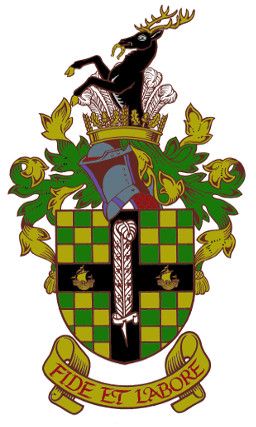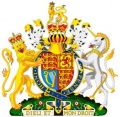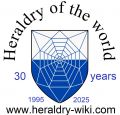Walsingham
|
Country :
Incorporated into:
Status:
|
| English |
Arms : Checky Or and Vert on a Cross Sable an Ostrich Feather in pale Ermine the quill transfixing a Scroll Argent between two Lymphads sails set Or. |
Origin/meaning
The arms were officially granted on December 20, 1962.
The black cross is from the arms of Walsingham Priory, which had its origins in the time of Edward the Confessor. The chapel of Our Lady of Walsingham was confirmed to the Augustinian Canons a century later and enclosed within the priory, it was in medieval times and still today a famous place of pilgrimage, attracting the faithful from all parts of England and from the continent. A manuscript dating from c. 1510 records the arms of the Priory of Walsingham as Argent on a cross sable five lilies slipped argent, (i.e. a black cross on a white background, with five lilies superimposed on the cross). The ermine ostrich feather refers to John of Gaunt, Duke of Lancaster, who in 1373 was presented with the Manor of Fakenham, which became known as Fakenham Lancaster. It continued as a Royal Manor until the 17th century when it was sold into private ownership. The ships refer to the areas maritime and naval connections, Admiral Sir Cloudesley Shovel and Rear-Admiral Sir John Narborough both being born in the district. The gold and green chequy pattern is taken from the arms of the Sparke family of Gunthorpe Hall.
The crown of wheatears and acorns is know as a "rural crown" and was created for the use of rural district councils. The black stag with golden antlers and hooves is derived from the dexter supporter of the arms of the Marquess Townshend, whose ancestral seat is at Raynham Hall. The plume of five white feathers is from the crest of Lord Hastings of Melton Constable. The golden horseshoe is taken from the crest of Thomas William Coke, 1st Earl of Leicester, famously known as Coke of Holkham, where it was held in the mouth of an ostrich. In his 88 years he revolutionised agricultural methods, converting an impoverished countryside into rich corn-growing land abounding with flocks and herds and so gave a lead to the whole country.
Literature: information from http://www.civicheraldry.co.uk
United Kingdom heraldry portal
This page is part of the United Kingdom heraldry portal |
Heraldry of the World |
|
Civic heraldry:
|
Other heraldry: |
Contact and Support
Partners:
Your logo here ?
Contact us
© 1995-2025, Heraldry of the World, Ralf Hartemink 
Index of the site












